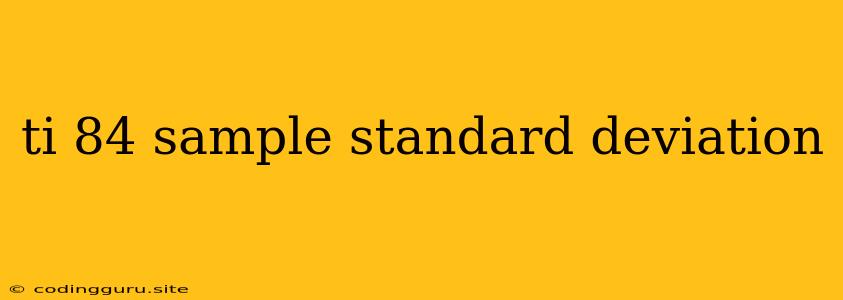Demystifying the TI-84: How to Calculate Sample Standard Deviation
The TI-84 calculator is a powerful tool for students and professionals alike, especially in the realm of statistics. One common statistical measure you might encounter is sample standard deviation, often represented by the symbol "s". It's a measure of how spread out your data is, giving you an idea of how much variation exists within your sample.
Let's break down the process of calculating sample standard deviation on the TI-84, understanding its significance, and even exploring a couple of practical examples.
Why is Sample Standard Deviation Important?
Think of it this way: you're trying to understand the heights of students in your class. You could simply take the average height, but that doesn't tell you the whole story. Some students might be very tall, some very short, and others somewhere in between. The sample standard deviation helps you quantify this "spread", providing a clearer picture of the data's overall distribution.
Calculating Sample Standard Deviation on the TI-84
1. Entering Your Data
- Press the STAT button on your calculator.
- Select 1:Edit to access the list editor.
- Enter your data into one of the lists (L1, L2, etc.).
2. Accessing the Statistical Calculations
- Press STAT again.
- Move to the CALC menu using the right arrow key.
- Select 1-Var Stats (for single-variable statistics).
3. Specifying Your Data List
- Enter the list where you stored your data (e.g., L1).
- Press ENTER.
4. Interpreting the Results
- Scroll down the output screen. Look for "Sx" (or sometimes "s"). This is the sample standard deviation for your data set.
Practical Examples: Understanding the Power of Sample Standard Deviation
Example 1: Comparing Test Scores
Imagine two classes took the same test. The average score in both classes is 75. However, the sample standard deviation in class A is 5, while in class B it's 10. This tells us:
- Class A: The scores are clustered closely around the average, indicating less variability.
- Class B: The scores are more spread out, suggesting greater variation in performance.
Example 2: Evaluating Investment Performance
You're considering two investment funds. Both have similar average returns. However, Fund A has a lower sample standard deviation than Fund B. This implies:
- Fund A: Returns are generally closer to the average, indicating less risk (volatility).
- Fund B: Returns are more volatile, potentially leading to larger swings in value.
Key Takeaways
- Sample standard deviation is a crucial statistic for understanding the spread or variability within a dataset.
- Using the TI-84 calculator makes it easy to calculate this value.
- The higher the sample standard deviation, the greater the variability within your data.
- Understanding the context of your data is important for interpreting sample standard deviation. It's not just a number; it provides insights into the nature of your data.
Remember, the TI-84 is your statistical ally. Utilize its capabilities effectively to gain a deeper understanding of your data and make informed decisions.
